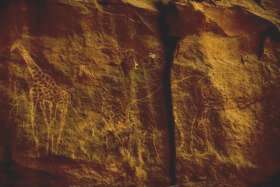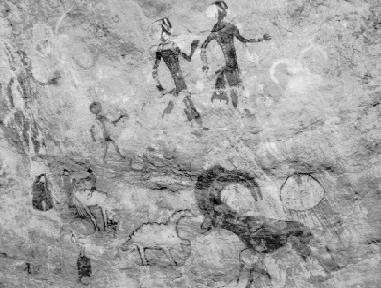Prehistoric North Africa
.svg.png)
The Prehistory of North Africa spans the period of earliest human presence in the region to gradual onset of historicity in the Maghreb during classical antiquity.
Early anatomically modern humans are known to have been present at Jebel Irhoud, in what is now Morocco, from about 300,000 years ago.[2] The Nile valley (Ancient Egypt) participated in the development of the Old World Neolithic, Bronze Age and Iron Age, along with the Ancient Near East. By contrast, the Maghreb, including the "Green Sahara", remained in the Mesolithic stage until the 4th millennium BC, with gradual introduction of the Neolithic nomadic pastoralism in the 3rd millennium BC, and early Iron Age Phoenician colonization along the Mediterranean coast from about 1100 BC.
Saharan Climate and Human Migration

Human habitation in North Africa has been greatly influenced by the climate of the Sahara (currently the world's largest warm desert), which has undergone enormous variations between wet and dry over the last few hundred thousand years.[3] This is due to a 41000-year cycle in which the tilt of the earth changes between 22° and 24.5°.[4] At present (2000 AD), we are in a dry period, but it is expected that the Sahara will become green again in 15000 years (17000 AD).
During the last glacial period, the Sahara was much larger than it is today, extending south beyond its current boundaries.[5] The end of the glacial period brought more rain to the Sahara, from about 8000 BC to 6000 BC, perhaps because of low pressure areas over the collapsing ice sheets to the north.[6] Once the ice sheets were gone, the northern Sahara dried out. In the southern Sahara, the drying trend was initially counteracted by the monsoon, which brought rain further north than it does today. By around 4200 BC, however, the monsoon retreated south to approximately where it is today,[7] leading to the gradual desertification of the Sahara.[8] The Sahara is now as dry as it was about 13,000 years ago.[3]
These conditions are responsible for what has been called the Sahara pump theory. During periods of a wet or "Green Sahara", the Sahara becomes a savanna grassland and various flora and fauna become more common. Following inter-pluvial arid periods, the Sahara area then reverts to desert conditions and the flora and fauna are forced to retreat northwards to the Atlas Mountains, southwards into West Africa, or eastwards into the Nile Valley. This separates populations of some of the species in areas with different climates, forcing them to adapt, possibly giving rise to allopatric speciation.
In terms of human evolution, the Saharan pump has been used to date four waves of human migration from Africa, namely:[9]
- Homo erectus (ssp. ergaster) into Southeast and East Asia
- Homo heidelbergensis into the Middle East and Western Europe
- Homo sapiens sapiens "Out of Africa theory"
- The spread of Afro-Asiatic languages (Berber and Egyptian to North Africa and Semitic to the Arabian Peninsula and Middle East).
Early and middle Paleolithic

The earliest inhabitants of central North Africa have left behind significant remains: early remnants of hominid occupation in North Africa, for example, were found in Ain el Hanech, near Saïda (c. 200,000 BCE); in fact, more recent investigations have found signs of Oldowan technology there, and indicate a date of up to 1.8 million BC.[11] Some studies have placed the earliest settlement of homo sapiens in North Africa to around 160,000 years ago[12] According to some sources, North Africa was the site of the highest state of development of Middle Paleolithic flake-tool techniques. Tools of this era, starting about 130,000 BCE, are called Aterian(after the site Bir el Ater, south of Annaba) and are marked by a high standard of workmanship, great variety, and specialization.
Humans in North Africa (Nazlet Sabaha, Egypt) are known to have dabbled in chert mining, as early as ~100,000 years ago, likely for use as tools.[13][14]
Late Paleolithic and Mesolithic
The earliest blade industries in North Africa belong to the Iberomaurusian or Oranian (after a site near Oran). This lithic industry appears to have spread throughout the coastal regions of North Africa between 15,000 and 10,000 BC. Between about 9000 and 5000 BC, the Capsian culture made its appearance showing signs to belong to the Neolithic and began influencing the Iberomaurusian, and after about 3000 BC the remains of just one human culture can be found throughout the former region. Neolithic society (marked by animal domestication and subsistence agriculture) spread in the Saharan and Mediterranean North Africa after the Levante between 6000 and 2000 BC. This type of economy, so richly depicted in the Tassili n'Ajjer cave paintings, predominated in North Africa until the classical period.

Saharan rock art was produced in the "Green Sahara" during the Neolithic Subpluvial period (about 8000 to 4000 BC). They were executed by hunter-gatherery of the Capsian period who lived in a savanna region teeming with giant buffalo, elephant, rhinoceros, and hippopotamus.
The Mesolithic cultures producing rock art (notably that at Tassili n'Ajjer in southeastern Algeria) flourished during the Neolithic Subpluvial.
Neolithic
In Prehistoric Egypt, Neolithic settlements appear from about 6000 BC.[15]
Other parts of North Africa began to participate in the Neolithic revolution just before the rapid desertification of the Sahara around 3500 BC.[16] The neolithization of North Africa was most likely introduced by waves of migration both from the Levant and from Iberia.[17]
Bronze Age to Iron Age
The beginning of the Bronze Age in Egypt is conventionally identified as the Protodynastic Period, following the Neolithic Naqada culture about 3200 BC. The Egyptian Bronze Age corresponds to the Old, Middle and New Kingdoms. The Iron Age in Egypt corresponds to the Third Intermediate Period of Egypt.
While the Nile valley (Egypt and Meroë) had entered historicity since the Bronze Age, the Maghreb remained in the prehistoric period longer. Mesolithic hunter-gatherers are gradually replaced by pastoralists (nomads) by the early 3rd millennium BC. Some Phoenician and Greek colonies were established along the Mediterranean coast during the 7th century BC.
See also
Notes
- ↑ According to UN country classification here: mmdkkd,.keoshttp://millenniumindicators.un.org/unsd/methods/m49/m49regin.htm. The disputed territory of Western Sahara (formerly Spanish Sahara) is mostly administered by Morocco; the Polisario Front claims the territory in militating for the establishment of an independent republic, and exercises limited control over rump border territories.
- ↑ Callaway, Ewan (7 June 2017). "Oldest Homo sapiens fossil claim rewrites our species' history". Nature. doi:10.1038/nature.2017.22114. Retrieved 5 July 2017.
- 1 2 Kevin White; David J. Mattingly (2006). "Ancient Lakes of the Sahara". 94 (1). American Scientist: 58–65.
- ↑ Orbit: Earth's Extraordinary Journey documentary
- ↑ Christopher Ehret. The Civilizations of Africa. University Press of Virginia, 2002.
- ↑ Fezzan Project — Palaeoclimate and environment. Retrieved March 15, 2006. Archived June 7, 2009, at the Wayback Machine.
- ↑ Sahara's Abrupt Desertification Started by Changes in Earth's Orbit, Accelerated by Atmospheric and Vegetation Feedbacks.
- ↑ Kröpelin, Stefan; et al. (2008). "Climate-Driven Ecosystem Succession in the Sahara: The Past 6000 Years" (PDF). Science. 320 (5877): 765–768. doi:10.1126/science.1154913. PMID 18467583.
- ↑ Stephen, Stokes. "Chronology, Adaptation and Environment of the Middle Palaeolithic in Northern Africa". Human Evolution, Cambridge University.
- ↑ http://www.geneawiki.com/index.php/Alg%C3%A9rie_-_Roknia
- ↑ Sahnouni 1998
- ↑ http://www.pnas.org/content/104/15/6128.long
- ↑ https://www.promine.com/blog/5-oldest-mines-in-the-world-a-casual-survey
- ↑ https://books.google.pl/books?id=f896CgAAQBAJ&pg=PA27&lpg=PA27&dq=nazlet+sabaha+mine+100,000&source=bl&ots=wVPXzN1z_Q&sig=0dSm_Pgdren8iu1i4QqVU1Ks0Mg&hl=pl&sa=X&ved=0ahUKEwjsw6Ha4rPZAhXnSt8KHUqWCawQ6AEIMTAB#v=onepage&q=nazlet%20sabaha%20mine%20100%2C000&f=false
- ↑ Redford, Donald B. Egypt, Canaan, and Israel in Ancient Times. (Princeton: University Press, 1992), p. 6.
- ↑ Sahara's Abrupt Desertification Started by Changes in Earth's Orbit, Accelerated by Atmospheric and Vegetation Feedbacks, Science Daily, "Archived copy". Archived from the original on 2014-03-07. Retrieved 2013-12-26.
- ↑ Rosa Fregel, Fernado L. Mendez, Youssef Bokbot, Dimas Martin-Socas, Maria D. Camalich-Massieu, Maria C. Avila-Arcos, Peter A. Underhill, Beth Shapiro, Genevieve L Wojcik, Morten Rasmussen, Andre E. R. Soares, Joshua Kapp, Alexandra Sockell, Francisco J. Rodriguez-Santos, Abdeslam Mikdad, Jonathan Santana, Aioze Trujillo-Mederos, Carlos D. Bustamante, "Neolithization of North Africa involved the migration of people from both the Levant and Europe" Proceedings of the National Academy of Sciences 115 (26) (June 2018), 6774-6779 doi:10.1073/pnas.1800851115 (biorxiv doi:10.1101/191569). Brenna M. Henn , Laura R. Botigué , Simon Gravel, Wei Wang, Abra Brisbin, Jake K. Byrnes, Karima Fadhlaoui-Zid, Pierre A. Zalloua, Andres Moreno-Estrada, Jaume Bertranpetit, Carlos D. Bustamante, David Comas, "Genomic Ancestry of North Africans Supports Back-to-Africa Migrations", PLOS (January 2012) doi:10.1371/journal.pgen.1002397.
References
- Original text: Library of Congress Country Study of Algeria
- AFRICA DURING THE LAST 150,000 YEARS (climate) from ORNL